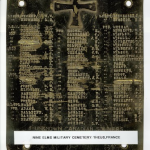Westmount, Quebec – 09 April 2016: 99 years ago this morning, in the snow and rain, the men of the 14th Battalion (RMR) – as part of the first assault wave of the entire Canadian Corps – rose out of their muddy trenches and began advancing towards their two objectives.

Prior to their attack they had moved into position, and according to the first volume of the Regiment’s history (pages 143-144): “…a few days earlier, on 05 April 1917, the 14th Battalion (RMR) moved forward to Maison Blanche, completing occupation at midnight and moving forward again on the following day into front line trenches (Thélus Sector) with Headquarters in Bentata Tunnel. This vast cavern, electrically lighted and provided with side chambers and passages, was used to shelter troops during assembly for the Vimy attack.”[1]
Until the end of April 2016, you can see some of the carvings and etchings that the men of the 14th Battalion (RMR) and other Canadian units left on the walls of these tunnels. 3D printed replicas are on display as part of CANADIGM’s Souterrain Impressions exhibition at the RMR’s armoury in Westmount. Admission is free of charge, the exhibit is open 7-days a week until 28 April 2016.

Again from the Regimental history:
“For the battle (of Vimy Ridge) each man of the 14th Battalion (RMR) was ordered to carry rifle, complete equipment less pack, 120 rounds of small arm ammunition, 2 Mills bombs (grenades), 5 sandbags, 48 hours’ rations, unexpended portion of current ration, waterproof sheet, box respirator (gas mask) worn at the alert, smoke helmet, goggles, 1 ground flare, and filled water bottle. In the case of bombers, rifle grenadiers, Lewis gunners, and runners, small arm ammunition was reduced to 50 rounds to permit the carrying of special equipment, or to aid rapid movement. Warrant officers and N.C.O’s. Were instructed to carry rifles with fixed bayonets, and officers were ordered to equip themselves with revolvers and Very signalling pistols. All ranks were ordered to wear steel helmets, and half of the Battalion was instructed to carry forward 33 picks and 67 shovels.”
“Sharp at 5:30 a.m. the attacking waves of the Regiment stepped over the parapet and advanced towards the German front line, which at the moment was suffering the destroying wrath of a marvellously placed barrage. In the ensuing hand to hand fighting the Royal Montrealers soon established superiority, but the enemy, by clever use of his machine guns, forced payment for the ground torn from his grasp.”

Vimy Ridge was the deepest advance the Allies had made in over two years of war. The Canadians had shown how a carefully planned, rehearsed, and subsequently well executed assault could lead to victory.
The RMR and the entire Canadian Corps was victorious at Vimy Ridge, however the price of victory was high. The RMR itself lost 98 killed and 176 wounded on that one day of battle, which was close to half of the Battalion’s effective strength at the time. If you ever find yourself in the area of Vimy, please visit the 80 RMR boys who are all buried together in Plot 1, row A of the Nine Elms Military Cemetery.
We will remember them.

[1] R.C. Featherstonhaugh, The Royal Montreal Regiment 14th Battalion C.E.F. 1914-1925, Montreal, The Gazette, Printing Co., Ltd., 1927, pp. 30-31.

